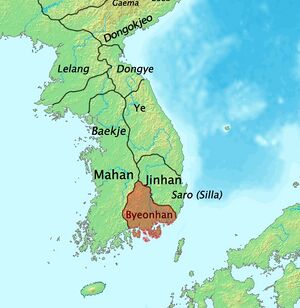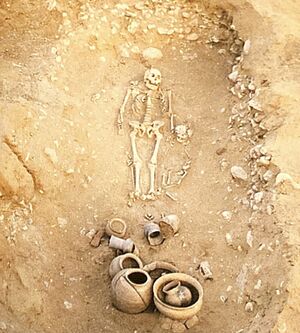اتحاد بيونهان
بيونهان ( Byeonhan ؛ الكورية: 변한; هانجا: 弁韓; رم: Byeonhan، النطق الكوري: [pjʌn.ɦan])، كمتا كان يـُعرف بإسم بيونجين Byeonjin،[1] (الكورية: 변진; هانجا: 弁辰; رم: Byeonjin, النطق الكوري: [pjʌn.dʑin]) كان اتحاداً فضفاضاً لزعامات قبائل تواجدت منذ ما يناهز ميلاد المسيح حتى القرن الرابع في جنوب شبه الجزيرة الكورية. Byeonhan was one of the Samhan (or "Three Hans"), along with Mahan and Jinhan.[2]
| اتحاد بيونهان | |
 The Korean peninsula in the 1st century, Byeonhan shaded in red. | |
| هانگول | 변한 or 변진 |
|---|---|
| هانچا | 弁韓 or 弁辰 |
| الرومنة المعدلة | Byeonhan or Byeonjin |
| مكيون-رايشاور | Pyŏnhan or Pyŏnjin |
|
ما قبل التاريخ
| ||||||

. . . . . . . . . . . . . . . . . . . . . . . . . . . . . . . . . . . . . . . . . . . . . . . . . . . . . . . . . . . . . . . . . . . . . . . . . . . . . . . . . . . . . . . . . . . . . . . . . . . . . . . . . . . . . . . . . . . . . . . . . . . . . . . . . . . . . . . . . . . . . . . . . . . . . . . . . . . . . . . . . . . . . . . .
التاريخ
هذا الجزء المبكر من فترة الممالك الثلاث يـُدعى أحياناً Proto–Three Kingdoms period. Byeonhan, like the other Samhan confederacies, appears descended from the Jin state of southern Korea.
Archaeological evidence indicates an increase in military activity and weapons production among the Byeonhan in the 3rd century, especially an increase in iron arrowheads and cuirasses (Barnes 2000).[2] This may be associated with the decline of Byeonhan and the rise of the more centralized Gaya Confederacy, which most Byeonhan states joined. Gaya was subsequently annexed by Silla, one of the Three Kingdoms of Korea.
Byeonhan was a country created by combining immigrants called Byeon (弁), existing Jin (辰) people and Han (韓) people. Among them, it is not clear to which ethnic group Byeon (弁) refers.
There are three primary hypotheses about the Byeon (弁) ethnic group:
- Before the unification of the Qin Dynasty, the mysterious maritime Wa people (倭) present in the Yangtze River and Shandong Peninsula.[3]
- The maritime people in Heo Hwang-ok legend at least claimed to be from India, Ayuta Kingdom (الكورية: 아유타국; هانجا: 阿踰陁國)[4][5][6][7][8]
- Any ethnic who traveled through ancient southern trade routes seen through the distribution of dolmens culture. According to recent studies that excavated Kofuns in South Jeolla Province, analysis of the components of glass beads there suggests that the raw material production area is Thailand[9]
الثقافة والتجارة
The Chinese Records of Three Kingdoms states that the language and culture of Byeonhan was essentially the same as Jinhan, and archaeological artifacts show little difference. Byeonhan may have simply referred to the chiefdoms in the south and west of the Nakdong River valley[10] which were not formal members of the Jinhan confederacy.
However, there are a few cultural aspects that were unique to Byeonhan. One notable tradition was full-body tattooing, which was done by both men and women.[11] Another tradition was the burying of feathers and pottery[12] in graves alongside the dead body as it was believed that the feathers helped the afterlife souls fly into the sky.[11]
According to the 3rd-century Chinese chronicle Records of Three Kingdoms, Byeonhan was known for the production of iron;[13] it exported iron to the commanderies of the Han dynasty to the north, Yamato Japan,[13][14] and the rest of the Korean peninsula.[15][16] It was also a center of stoneware manufacture.
الدويلات الأعضاء
According to the Records of Three Kingdoms, Byeonhan consisted of 12 دويلة:
- Mirimidong (미리미동국/彌離彌凍國)، حالياً Miryang.
- Jeopdo (접도국/接塗國)، حالياً هامان.
- Gojamidong (고자미동국/古資彌凍國)، حالياً گوسونگ.
- Gosunsi (고순시국/古淳是國)، حالياً Jinju, Sacheon or Goseong.
- Ballo (반로국/半路國)، حالياً Seongju.
- Nangno (낙노국/樂奴國)، حالياً Hadong or Namhae.
- Gunmi (군미국/軍彌國)، حالياً Sacheon.
- Mioyama (미오야마국/彌烏邪馬國)، حالياً Goryeong.
- گامنو (감로국/甘路國)، حالياً Gimcheon.
- گويا (구야국/狗邪國)، حالياً Gimhae.
- Jujoma (주조마국/走漕馬國)، حالياً Gimcheon.
- Anya (안야국/安邪國)، حالياً Haman.
- Dongno (독로국/瀆盧國)، حالياً Dongnae.
المراجع
- Barnes, G.L. (2000). "Archeological armor in Korea and Japan: Styles, technology and social setting". Journal of East Asian Archeology 2 (3–4), 61–96. (Electronic Version).
- ^ Huiyi, Yi; Songsu, Park; Naehyon, Yun (2005). New history of Korea. Seoul: Jimundang. p. 136. ISBN 8988095855.
- ^ أ ب Ebrey, Patricia; Walthall, Anne (2013-01-01). Pre-Modern East Asia: A Cultural, Social, and Political History, Volume I: To 1800. Cengage Learning. p. 101. ISBN 978-1133606512.
- ^ Classic of Mountains and Seas (山海經)
- ^ presumed to be Ayodhya or possibly Ay Kingdom in (present-day Tamil Nadu) that was a vassal of Pandyan Empire
- ^ Samguk Yusa > 金官城婆娑石塔 : 金官虎溪寺婆娑石塔者昔此邑爲金官國時, 世祖首露王之妃許皇后名黄玉, 以東漢建武二十四年甲申, 自西域阿踰陁國所載來. 初公主承二親之命泛海將指東, 阻波神之怒不克而還白父王. 父王命載兹塔, 乃獲利渉來泊南涯. 有緋㠶茜旗珠玉之羙, 今云主浦. 初解綾袴於岡上處曰綾峴, 茜旗初入海涯曰旗出邊. 塔方四面五層, 其彫𨩐甚竒. 石微赤班色其質良脆, 非此方類也. 本草所云, 㸃雞冠血爲驗者是也. Geumgwan province Pasa pagoda : The Pasa stone pagoda of Geumgwan Gaya temple was carried by Heo, the queen of King Suro, from Ayuta Kingdom in the West. The princess tried to cross the sea to the east by her parents' orders. But the anger of the sea god failed to start. As the father, ordered her to carry the tower, then she was able to cross the sea easily. It moored on the south coast. It is now called 主浦 because it carries beautiful things such as red sails, red flags, and red jade. The first place where the silk were drop on the hill is called 綾峴. The coast where the red flag first came in is called the 旗出邊. The pagoda has four sides and fifth floor, and the sculpture is very unique. The stone has a color of red spots. The stone is soft. Therefore, it does not come from our country. This is what 本草 said, that the blood of the chicken's crest was examined by dipping it into a stone.
- ^ 이거룡. 2020, "김해 파사석탑의 유실(遺失) 부재(部材)에 관한 연구", 동아시아불교문화, no.41, pp.279-311. / A Study on the Missing Members of the Pasa Stone Pagoda
- ^ "A stone that is not on the Korean Peninsula. Queen Heo of Garakguk, "Status of the Pagoda."". Kyunghyang Shinmun. 17 December 2019.
- ^ Doubts due to linguistic connection between Korean and Tamil language
- ^ "about Sinduck Kofun article". The Dong-a Ilbo. 10 August 2021.
- ^ Yi, Kwang-kyu (2003). Korean studies series (Korean Studies series 25 ed.). Seoul: Jipmundang. pp. 24–27. ISBN 8988095499.
- ^ أ ب 박, 은봉; 김, 용란 (2004). 한국사 1. Seoul, South Korea: 교원 All Story. p. 32. ISBN 89-21-42395-8.
- ^ 이, 소영 (2019). "弁韓 西部地域 瓦質土器文化 硏究" [A study on the Culture of Wijil Pottery of the western ByeonHan (弁韓) Areas]. 사학과 고고학. Jinju, South Korea. 8: vi - 97 – via Riss.
- ^ أ ب Lee, Injae; Miller, Owen; Park, Inhoon (2014). Korean History in Maps. Cambridge University Press. pp. 18–19. ISBN 978-1107098466.
- ^ Kyong-hee, Won Yu han ; translated by Lee (2006). Money traditional Korean society. Seoul, Korea: Ewha Womans University Press. pp. 17–18. ISBN 8973006746.
{{cite book}}: CS1 maint: multiple names: authors list (link) - ^ Mong-nyong, Choi (2006). 최근 의 고고학 자료 로 본 한국 고고학, 고대사 의 신 연구(Recent research on archaeology and ancient deities. Seoul: Juryusung. p. 41. ISBN 9788987096650.
- ^ 이, 양수 (2011). "弁韓의 對外交易" [Foreign trade of Byeonhan in the Samhan period (4C B.C-3C A.D)]. 부산고고학회. 8: 27–63 – via RISS.